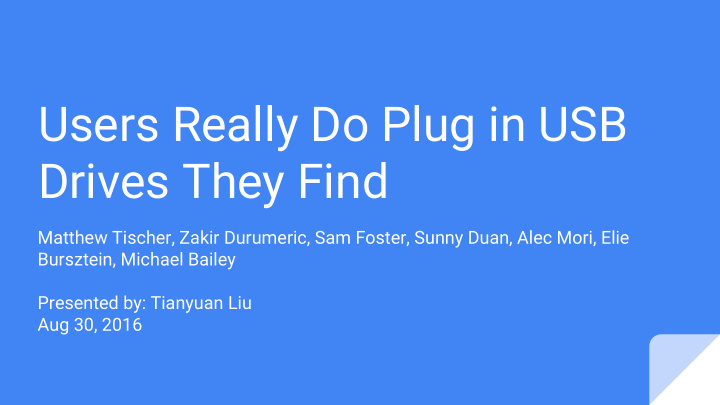



Users Really Do Plug in USB Drives They Find Matthew Tischer, Zakir Durumeric, Sam Foster, Sunny Duan, Alec Mori, Elie Bursztein, Michael Bailey Presented by: Tianyuan Liu Aug 30, 2016
“Do NOT plug any USB drive you find on campus into your workstation.” -- Google Security Training 2
Experimental Setup ● Dropping 297 USB drives on UIUC campus 30 locations ○ ○ 5 types ○ 2 times a day Appearances ● 3
Experimental Setup ● .html files track when a file is opened 4
Results 290/297 drives were picked up ● Files on 135/297(45%) drives ● were opened ● 58/135 took the survey Drives with return label showed ● less likely to be plugged in 5
Data Interpretation -- Fisher’s Exact Test A diet example [1] P-value indicates how likely two datasets comes from the same distribution. E.g. Are male and female equally likely to be on a diet? 6 [1] Fisher's exact test, https://en.wikipedia.org/wiki/Fisher%27s_exact_test
Data Interpretation -- Participants Assessment ● How vulnerable are the participants compared to general people? UIUC students and staffs ○ ● Baselines: DOSPERT [2] ○ ■ Risk taking and risk perception of 359 participants SeBIS [3] ○ ■ Security compliance of 3,619 participants ● Method ○ Reuse the same questions in the survey Compare results ○ [2] Blais, Ann-Renée, and Elke U. Weber. "A domain-specific risk-taking (DOSPERT) scale for adult populations." Judgment and Decision Making 1.1 (2006). 7 [3] Egelman, Serge, and Eyal Peer. "Scaling the security wall: Developing a security behavior intentions scale (sebis)." Proceedings of the 33rd Annual ACM Conference on Human Factors in Computing Systems . ACM, 2015.
Example questions ● DOSPERT ○ Admitting that your tastes are different from those of a friend. ○ Betting a day's income at the horse races. ○ Drinking heavily at a social function. 8
Example questions ● SeBIS ○ I frequently backup my computer. ○ I am careful to never share confidential documents stored on my home or work computers. ○ I never give out passwords over the phone. 9
Data Interpretation -- Take Aways ● Participants are more risk averse than general population. (v.s. DOSPERT) ● The security behavior of participants is not significantly different from peer students. (v.s. SeBIS) 10
Discussion 11
Conclusion ● What are the key contributions? What is the limitation of this paper? ● ● Do you agree with the claims made in this paper? E.g. ○ Participants picking up the drives are altruistic and curious. ○ College students are more risk averse than general population. Social engineering attack will work on general people. ○ ● What would you do if you spot a USB drive somewhere? 12
“If you do find a USB drive, turn it to security desk.” -- Google Security Training 13
Thanks. 14
Recommend
More recommend